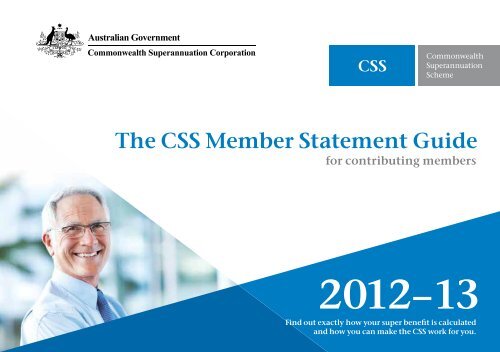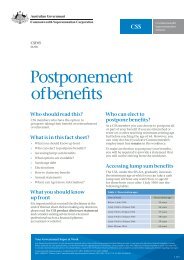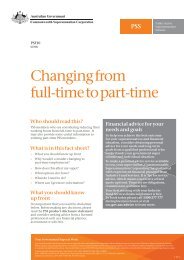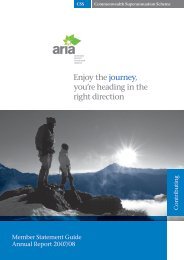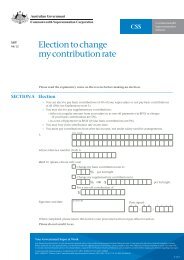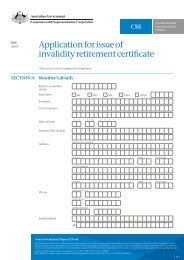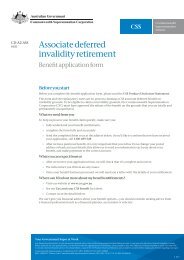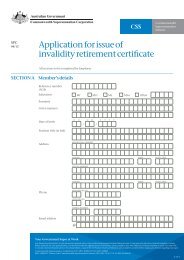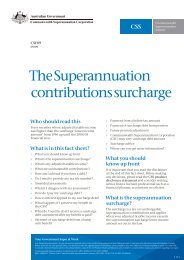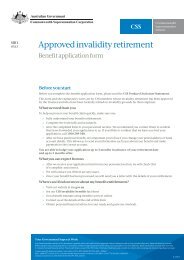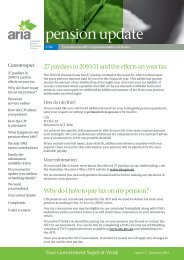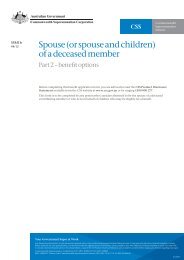The CSS Member Statement Guide
The CSS Member Statement Guide
The CSS Member Statement Guide
Create successful ePaper yourself
Turn your PDF publications into a flip-book with our unique Google optimized e-Paper software.
<strong>The</strong> <strong>CSS</strong> <strong>Member</strong> <strong>Statement</strong> <strong>Guide</strong><br />
for contributing members<br />
2012–13<br />
Find out exactly how your super benefit is calculated<br />
and how you can make the <strong>CSS</strong> work for you.
<strong>The</strong> guide<br />
Use the following guide to help you navigate the different<br />
sections of your <strong>Member</strong> <strong>Statement</strong>.<br />
Contributing <strong>Member</strong> <strong>Statement</strong><br />
1 July 2012–30 June 2013<br />
Your benefit options Please refer to your <strong>Member</strong> <strong>Statement</strong> <strong>Guide</strong> for further explanation.<br />
Amounts on this <strong>Statement</strong> are based on information supplied by employers and may be subject to adjustment.<br />
Further information explaining parts of this <strong>Member</strong> <strong>Statement</strong> can be found in your <strong>Member</strong> <strong>Statement</strong> <strong>Guide</strong> provided in this pack.<br />
Your resignation benefit<br />
Your age retirement benefit<br />
Your details<br />
*Are your details incorrect? If so, please let your personnel section know.<br />
What you would have been<br />
What you would have been<br />
Name* Your options if you resign<br />
allocated on exit on 30/6/13Your contribution Your options rate at 30 if you June retire 2013*<br />
allocated on exit on 30/6/13<br />
1. Preserve total benefit<br />
1. CPI-indexed pension*<br />
in the <strong>CSS</strong><br />
(per year)<br />
Date of birth* Your employment status at 30 June 2013*<br />
(generally a deferred CPI-indexed<br />
Plus Deferred employer benefit<br />
Plus Lump sum<br />
pension entitlement)<br />
†<br />
Account (AGS) number<br />
Your hours per OR fortnight 2. CPI-indexed at 30 June pension* 2013*<br />
OR 2. Lump sum now <br />
(per year)<br />
Plus Lump sum paid into<br />
Plus Non-indexed pension<br />
Remember to quote your a AGS rollover number fund when making enquiries about your superannuation.<br />
(per year)<br />
Your superannuation salary at 30 June 2013*<br />
Tax File Number provided*<br />
If you have not reached your preservation age at claim date, payment of your lump Plus Lump sum †<br />
sum will be limited to the amount of your SIS upper limit. <strong>The</strong> remainder will<br />
Based on your salary remain and recognised preserved allowances in a rollover at your institution most recent until birthday. you reach For members your preservation working age. OR 3. Lump sum † (ex-provident<br />
part-time, the salary shown is the amount you would receive if you were working full-time.<br />
account members only)<br />
Your membership commenced on*<br />
Your period of contributory membership<br />
* A pension adjusted twice-yearly, based on increases in the Consumer Price<br />
Index (CPI).<br />
Rate of allotment of net earnings 1/7/12 to 30/6/13 #<br />
# See page 1 of the <strong>Member</strong> <strong>Statement</strong> <strong>Guide</strong> for an explanation of the calculation of this rate.<br />
† Includes productivity if administered by ComSuper, any super co-contributions<br />
<strong>CSS</strong> investment and transfer amounts. 1 year to 5 years to 10 years to<br />
option performance 30 June 2013 30 June 2013 30 June 2013<br />
Default Fund 13.6% 3.3% 6.8%<br />
Cash Investment Option 2.8% 3.7% 4.4%•<br />
This is important<br />
<strong>The</strong> information in this <strong>Member</strong> <strong>Statement</strong> <strong>Guide</strong> (MSG) is general<br />
information only and has been prepared without taking into account your<br />
personal objectives, financial situation or needs. You should consider any<br />
advice in this MSG in light of your personal objectives, financial situation<br />
or needs before acting on it.<br />
You may wish to contact a licensed financial planner to do this. If you are<br />
looking at acquiring a financial product, you should obtain a product<br />
disclosure statement (PDS) and consider its contents before making<br />
any decisions.<br />
This document is part of your periodic statement for your <strong>CSS</strong> super<br />
account and was prepared on 15 August 2013 by the Commonwealth<br />
Superannuation Corporation (CSC) ABN: 48 882 817 243 AFSL: 238069<br />
RSEL: L0001397, Trustee of the <strong>CSS</strong> ABN: 19 415 776 361 RSE: R1004649.<br />
<strong>The</strong> components of your periodic statement are the <strong>Member</strong> <strong>Statement</strong>,<br />
Transaction Summary and <strong>Member</strong> <strong>Statement</strong> <strong>Guide</strong> (MSG).<br />
<strong>The</strong> 2012–13 Annual Report will be available online at css.gov.au<br />
We are required to provide you with any additional information you<br />
may reasonably need to understand your investment in the <strong>CSS</strong>,<br />
including your benefit entitlements (such as death and invalidity benefits).<br />
Details of investment options that may be available to you are also available<br />
on request from CSC. To access or request this information, please contact<br />
us as set out in the Contact us section of this MSG.<br />
<strong>The</strong> invalidity and death benefits provided below are the default options provided • Please by note the <strong>CSS</strong> that the that cash are investment payable to option either commenced you or your on dependants. 1 December 2004 Please and refer this to your <strong>Member</strong><br />
<strong>Statement</strong> <strong>Guide</strong> to see if there are any other benefit options available to you. <strong>The</strong><br />
figure<br />
below<br />
reflects<br />
amounts<br />
the performance<br />
have been<br />
from<br />
calculated<br />
1 December<br />
assuming<br />
2004 to 30<br />
that<br />
June<br />
your<br />
2013.<br />
benefit would not be reduced<br />
All returns are calculated as the compound average rate of earnings after fees and taxes.<br />
because of the application of a BCC.<br />
Be aware that long-term performance figures outlined above are for the investment options<br />
as a whole and are not your personalised investment returns in <strong>CSS</strong>.<br />
Your benefit if you are retired on invalidity<br />
Your death benefit<br />
Your super details<br />
Your options if you become<br />
What you would have been<br />
an invalid<br />
allocated on exit on 30/6/13<br />
Your value in the Fund is made up of the following components:<br />
Maximum pension<br />
Benefit component<br />
What you would<br />
Contributions/<br />
Plus Lump sum<br />
have been allocated<br />
Amounts received<br />
on exit on 1/7/12<br />
1/7/12 to 30/6/13<br />
1. Your member component<br />
consisting of basic contributions and earnings<br />
Your eligible spouse’s option if<br />
What would have been<br />
you die<br />
allocated on exit on 30/6/13<br />
Maximum pension<br />
Fund<br />
What you would have<br />
Plus Lump sum earnings<br />
been allocated on<br />
1/7/12 to 30/6/13<br />
exit on 30/6/13<br />
OR<br />
Lump sum payable to your estate<br />
and supplementary contributions and earnings<br />
2. Your productivity component<br />
3. Super co-contributions<br />
4. Transfer amounts<br />
5. Total equity (1+2+3+4)<br />
Other important information<br />
Benefit classification certificate (BCC)<br />
Superannuation guarantee top up<br />
Contributions paid since 30/6/07<br />
Your preservation age<br />
Minimum amount on exit<br />
Your SIS upper limit<br />
Ex-provident account member Your preserved benefit at 30/6/13<br />
Restricted units Your restricted non-preserved benefit at 30/6/13<br />
Rejected units Your unrestricted non-preserved benefit at 30/6/13<br />
Age 60 units<br />
Investment option<br />
Your surcharge debt Your total surcharge debt from the Australian Taxation Office’s (ATO) assessment of your surchargeable contributions.<br />
Surcharge debt<br />
Surcharge debt incurred<br />
Payments<br />
Interest<br />
Surcharge debt<br />
at 1/7/12<br />
1/7/12 to 30/6/13<br />
1/7/12 to 30/6/13<br />
1/7/12 to 30/6/13<br />
at 30/6/13<br />
CCMSP2 2013<br />
i
Date of birth* Your employment status at 30 June 2013*<br />
in the <strong>CSS</strong><br />
Plus Deferred employer benefit<br />
(per year)<br />
(generally a deferred CPI-indexed<br />
Plus Lump sum<br />
pension entitlement)<br />
†<br />
Account (AGS) number<br />
Your hours per fortnight at 30 June 2013*<br />
OR 2. CPI-indexed pension*<br />
OR 2. Lump sum now <br />
(per year)<br />
Three simple steps to guide you through<br />
Plus Lump sum paid into<br />
Plus Non-indexed pension<br />
Remember to quote your AGS number when making enquiries about your superannuation.<br />
a rollover fund<br />
(per year)<br />
Your superannuation salary at 30 June 2013*<br />
Tax File Number provided*<br />
If you have not reached your preservation age at claim date, payment of your lump Plus Lump sum †<br />
sum will be limited to the amount of your SIS upper limit. <strong>The</strong> remainder will<br />
remain preserved in a rollover institution until you reach your preservation age.<br />
Based on your salary and recognised allowances at your most recent birthday. For members working<br />
OR 3. Lump sum † (ex-provident<br />
part-time, the salary shown is the amount you would receive if you were working full-time.<br />
account members only)<br />
Your membership commenced on*<br />
Your period of contributory membership<br />
* A pension adjusted twice-yearly, based on increases in the Consumer Price<br />
Index (CPI).<br />
Rate of allotment of net earnings 1/7/12 to 30/6/13 #<br />
<strong>CSS</strong> investment<br />
option performance<br />
1 year to<br />
30 June 2013<br />
5 years to<br />
30 June 2013<br />
10 years to<br />
30 June 2013<br />
† Includes productivity if administered by ComSuper, any super co-contributions<br />
and transfer amounts.<br />
Cash Investment Option 2.8%<br />
• Please <strong>The</strong> invalidity note that the and cash death investment benefits option<br />
1. Your super details figure <strong>Statement</strong> (see reflects the <strong>Guide</strong> page performance to see if from there 1) 1 December are<br />
All because returns are of calculated the application as the compound of a BCC.<br />
are payable to either you or your dependants. Please refer to your <strong>Member</strong><br />
have 2. been calculated Your assuming that your benefit would not reduced options (see page 3)<br />
3.7% 4.4%•<br />
provided commenced below on are 1 December the default 2004 options and this provided by the <strong>CSS</strong> that<br />
any other 2004 benefit to 30 June options 2013. available to you. <strong>The</strong> below amounts<br />
average rate of earnings after fees and taxes.<br />
Be aware that long-term performance figures outlined above are for the investment options<br />
as a whole and are not your personalised investment returns in <strong>CSS</strong>.<br />
Your benefit if you are retired on invalidity<br />
Your death benefit<br />
Your super details<br />
Your options if you become<br />
an invalid<br />
Your value in the Fund is made up of the following components:<br />
Maximum pension<br />
What you would have been<br />
allocated on exit on 30/6/13<br />
Your benefit options What Please would refer have to been your <strong>Member</strong> <strong>Statement</strong> <strong>Guide</strong> for further explanation.<br />
Your eligible spouse’s option if<br />
you die<br />
allocated on exit on 30/6/13<br />
Maximum Your pension resignation benefit<br />
Your age retirement benefit<br />
Benefit component<br />
What you would<br />
Contributions/<br />
Fund<br />
What you would have<br />
What you would have been<br />
What you would have been<br />
have been allocated<br />
Amounts received Plus Lump sum earnings<br />
been allocated on<br />
Plus Lump Your sumoptions if you resign<br />
Your options if you retire<br />
allocated on exit on 30/6/13<br />
allocated on exit on 30/6/13<br />
on exit on 1/7/12<br />
1/7/12 to 30/6/13<br />
1/7/12 to 30/6/13<br />
exit on 30/6/13<br />
1. Preserve total benefit<br />
1. CPI-indexed pension*<br />
in the <strong>CSS</strong> OR<br />
(per year)<br />
1. Your member component<br />
(generally a deferred CPI-indexed<br />
Lump sum Plus payable Deferred to your estate employer benefit<br />
Plus Lump sum<br />
pension entitlement)<br />
†<br />
consisting of basic contributions and earnings<br />
OR 2. CPI-indexed pension*<br />
OR 2. Lump sum now <br />
(per year)<br />
and supplementary contributions and earnings<br />
Plus Lump sum paid into<br />
Plus Non-indexed pension<br />
a rollover fund<br />
(per year)<br />
2. Your productivity component<br />
If you have not reached your preservation age at claim date, payment of your lump Plus Lump sum †<br />
3. Super co-contributions<br />
sum will be limited to the amount of your SIS upper limit. <strong>The</strong> remainder will<br />
remain preserved in a rollover institution until you reach your preservation age. OR 3. Lump sum † (ex-provident<br />
account members only)<br />
4. Transfer amounts<br />
* A pension adjusted twice-yearly, based on increases in the Consumer Price<br />
5. Total equity (1+2+3+4)<br />
Index (CPI).<br />
† Includes productivity if administered by ComSuper, any super co-contributions<br />
Other important information<br />
and transfer amounts.<br />
# See page 1 of the <strong>Member</strong> <strong>Statement</strong> <strong>Guide</strong> for an explanation of the calculation of this rate.<br />
Default Fund 13.6% 3.3% 6.8%<br />
Benefit classification certificate (BCC)<br />
Superannuation guarantee top up<br />
Contributions paid since 30/6/07<br />
Minimum amount on exit<br />
Your preservation age<br />
<strong>The</strong> invalidity and death benefits provided below are the default options provided by the <strong>CSS</strong> that are payable to either you or your dependants. Please refer to your <strong>Member</strong><br />
Your SIS upper <strong>Statement</strong> limit <strong>Guide</strong> to see if there are any other benefit options available to you. <strong>The</strong> below amounts have been calculated assuming that your benefit would not be reduced<br />
because of the application of a BCC.<br />
Ex-provident account member Your preserved Your benefit benefit at if 30/6/13 you are retired on invalidity<br />
Restricted units Your restricted Your non-preserved options if you become benefit at 30/6/13 What you would have been<br />
an invalid<br />
allocated on exit on 30/6/13<br />
Rejected units Your unrestricted Maximum non-preserved pension benefit 30/6/13<br />
3. Other important information (see page 6)<br />
Age 60 units<br />
Investment Plus option Lump sum<br />
Your death benefit<br />
Your eligible spouse’s option if<br />
you die<br />
Maximum pension<br />
Plus Lump sum<br />
What would have been<br />
allocated on exit on 30/6/13<br />
Your surcharge debt Your total surcharge debt from the Australian Taxation Office’s (ATO) assessment of your surchargeable contributions.<br />
Surcharge debt<br />
Surcharge debt incurred<br />
Payments<br />
Interest<br />
Surcharge debt<br />
at 1/7/12<br />
1/7/12 to 30/6/13<br />
1/7/12 to 30/6/13<br />
1/7/12 to 30/6/13<br />
at 30/6/13<br />
Lump sum payable to your estate<br />
OR<br />
CCMSP2 2013<br />
Other important information<br />
Benefit classification certificate (BCC)<br />
Superannuation guarantee top up<br />
Contributions paid since 30/6/07<br />
Your preservation age<br />
Minimum amount on exit<br />
Your SIS upper limit<br />
Ex-provident account member Your preserved benefit at 30/6/13<br />
Restricted units Your restricted non-preserved benefit at 30/6/13<br />
Rejected units Your unrestricted non-preserved benefit at 30/6/13<br />
Age 60 units<br />
Investment option<br />
ii
1. Your super details<br />
Rate of allotment of net earnings<br />
1 July 2012 to 30 June 2013<br />
<strong>The</strong> calculation of the rate of allotment of net earnings takes into<br />
account fund earnings, your opening balance and other changes<br />
to your account balance such as contributions and transfers paid<br />
into your account during the reporting period. <strong>The</strong> net change to<br />
your opening account balance is averaged across the year to make<br />
this calculation.<br />
Investment option performance<br />
All returns are calculated as the compound average rate of earnings<br />
after fees and taxes.<br />
Please note that the Cash investment option has not been in force<br />
for ten years as it commenced on 1 December 2004. <strong>The</strong>refore, the<br />
figure shown in the last column reflects the performance from<br />
1 December 2004 to 30 June 2013.<br />
Be aware that long-term performance figures shown on the <strong>Member</strong><br />
<strong>Statement</strong> are for the investment options as a whole and are not your<br />
personalised investment returns in <strong>CSS</strong>. For more information about<br />
investments visit css.gov.au<br />
Your productivity component (if applicable)<br />
Your productivity component is made up of the amount your<br />
employer contributes each fortnight (less 15% contributions tax<br />
on payments made after July 1990) and any accrued fund earnings<br />
(positive or negative) on those employer contributions.<br />
Super co-contributions<br />
This section shows any Australian Tax Office (ATO) super<br />
co-contributions made and fund earnings (positive or negative).<br />
If you made personal contributions to the <strong>CSS</strong> in 2012–13 which<br />
qualify for the super co-contribution, you won’t receive the payment<br />
until after 30 June 2013 (so it won’t be shown in this section).<br />
This is because you need to lodge your 2012–13 income tax return<br />
before the ATO can assess if you’re eligible. When they confirm you’re<br />
eligible, they automatically calculate the amount and deposit it<br />
directly into the <strong>CSS</strong>.<br />
When you stop working and take your <strong>CSS</strong> benefit, any super<br />
co-contributions you have received will be paid to you as a lump sum.<br />
This will be in addition to the benefit you accrued while you were a<br />
<strong>CSS</strong> member.<br />
For more information on co-contributions visit ato.gov.au<br />
Components of your total benefit<br />
Your member component<br />
Your member component is made up of your personal basic and<br />
supplementary contributions and accrued fund earnings (positive or<br />
negative) on those contributions.<br />
1
Transfer amounts<br />
This section shows any amounts you’ve transferred from other<br />
super funds. When you stop working and take your <strong>CSS</strong> benefit,<br />
any transfer amounts will be paid to you as a lump sum. This is in<br />
addition to the benefit you accrued while you were a <strong>CSS</strong> member.<br />
Total equity<br />
This section shows the total value of your equity amounts at<br />
1 July 2012 and 30 June 2013. It includes your member component,<br />
productivity component, super co-contributions and transfer amounts.<br />
What you would have been allocated on exit on 1/7/12<br />
This section shows the withdrawal benefit that would have been<br />
paid to you if you had ended your membership and your benefit was<br />
processed on 1 July 2012.<br />
Contributions/amounts received 1/7/12 to 30/6/13<br />
This section shows your personal basic contributions, supplementary<br />
contributions and productivity contributions, along with any<br />
co-contributions or transfer amounts, paid into your account during<br />
the financial year.<br />
For contributing members, the earnings are allocated monthly on the<br />
basis of the rates determined for that month.<br />
Keep in mind that if you leave as an age retiree, your consumer<br />
price index (CPI)-indexed pension isn’t affected by investment<br />
performance, because it’s determined by your final superannuation<br />
salary, length of membership and age at exit.<br />
<strong>The</strong> member and productivity components of your benefit, and<br />
any super co-contributions or money you’ve transferred from other<br />
funds, are affected by fund earnings. See our PDS at css.gov.au for<br />
more details.<br />
What you would have been allocated on exit on 30/6/13<br />
This section shows the funded withdrawal benefit that would have<br />
been paid to you if you had ended your membership and your benefit<br />
was processed on 30 June 2013.<br />
Keep in mind that the amounts on which this information is based<br />
may change. You should get more information from us about your<br />
benefits before making a claim for your <strong>CSS</strong> entitlement.<br />
Fund earnings 1/7/12 to 30/6/13 (net)<br />
This column shows the fund earnings for the year, for each<br />
component of your benefit (for more information on performance<br />
see our Annual Report at css.gov.au).<br />
CSC determines an earning rate for the Default and Cash Investment<br />
Option for every business day. <strong>The</strong>se rates are used to calculate<br />
entitlements for members exiting the <strong>CSS</strong>.<br />
2
2. Your benefit options<br />
Your resignation benefit<br />
If you resign, you can choose one of the following options, depending on<br />
your circumstances:<br />
1. Preserve all your benefits in the <strong>CSS</strong> until you reach your<br />
minimum retirement age (generally 55). This will become a<br />
deferred benefit which you can take in the following ways:<br />
• CPI-indexed pension and a lump sum of member and<br />
productivity components. If you’re under the age of 60<br />
when you claim your deferred benefit, and not permanently<br />
leaving the workforce, any amount of your member<br />
component in excess of your SIS upper limit together with<br />
your productivity component must be paid into a rollover<br />
fund if taken as a lump sum.<br />
• CPI-indexed pension and a non-indexed pension purchased<br />
with member and productivity components.<br />
• CPI-indexed pension and a non-indexed pension purchased<br />
with your member component only and a lump sum of your<br />
productivity component.<br />
• A lump sum, if you’re an ex-provident account member and<br />
you claim your preserved (deferred) benefit on (or after)<br />
reaching the age of 60.<br />
2. You can take your member component as a lump sum up to<br />
your SIS upper limit. Any excess above the SIS upper limit must<br />
be paid into a rollover fund along with your superannuation<br />
guarantee top-up and productivity component. If you choose<br />
this option, you will forego most of your employer-financed<br />
component, which could be the largest component of your<br />
benefit. We recommend you seek professional financial advice<br />
before selecting this option.<br />
3. You may have the option to pay your <strong>CSS</strong> benefit (your member,<br />
productivity and employer components) as a transfer value into<br />
an eligible superannuation scheme. For a list of eligible super<br />
funds visit css.gov.au<br />
Any amounts shown on your <strong>Member</strong> <strong>Statement</strong> reflect your situation<br />
on the date shown and may change. You can use the <strong>CSS</strong> i-Estimator to<br />
estimate your resignation benefit and other benefit options at various<br />
dates. You’ll need an access number to use this service. If you don’t<br />
have an access number or you’ve misplaced it call 1300 000 277.<br />
For more information about your resignation benefit options,<br />
see our <strong>CSS</strong> Preservation of benefits fact sheet at css.gov.au or<br />
call 1300 000 277.<br />
Your age retirement benefit<br />
If you retire, you can choose one of the following options:<br />
1. CPI-indexed pension and a lump sum of member and<br />
productivity components. If you’re under the age of 60 when<br />
you claim your age benefit, and not permanently leaving the<br />
workforce, any amount of your member component in excess of<br />
your SIS upper limit together with your productivity component<br />
must be paid into a rollover fund.<br />
2. CPI-indexed pension and a non-indexed pension purchased with<br />
member and productivity components.<br />
3. CPI-indexed pension and a non-indexed pension purchased<br />
with your member component only and take a lump sum of your<br />
productivity component.<br />
4. If you’re an ex-provident account member and you retire at the<br />
age of 60 or later, you can take your total benefit as a lump sum.<br />
If you’re not permanently leaving the workforce, you can postpone the<br />
payment of all, or some, of your age retirement benefit.<br />
3
<strong>The</strong> amounts shown in this section reflect your benefit at<br />
30 June 2013 and may change. You can use the <strong>CSS</strong> i-Estimator to<br />
estimate your retirement benefits and other benefit options at various<br />
dates. You’ll need an access number to use this service. If you don’t<br />
have an access number or you’ve misplaced it call 1300 000 277.<br />
For more information about your retirement benefit options visit<br />
css.gov.au or call us on 1300 000 277.<br />
Your benefit if you are retired on invalidity<br />
As a <strong>CSS</strong> contributing member you automatically receive permanent<br />
invalidity cover at no extra cost.<br />
You’re covered for a benefit based on the entitlement you would have<br />
received if you’d worked to age 65.<br />
<strong>The</strong> invalidity benefit shown on your <strong>Member</strong> <strong>Statement</strong> is the<br />
default option provided by the <strong>CSS</strong> that is payable to you if you don’t<br />
select an alternative benefit option. This is Option 1.<br />
Any amounts shown in this section reflect your situation at<br />
30 June 2013 and may change. <strong>The</strong>y have been calculated assuming<br />
that your benefit would not be reduced because of the application<br />
of a benefit classification certificate (BCC). If you have a BCC and<br />
would like to know the amount of benefit that would be payable on<br />
invalidity call 1300 000 277. Your BCC status is shown in the<br />
‘other important information’ section on the reverse side of your<br />
<strong>Member</strong> <strong>Statement</strong>.<br />
In the event of permanent invalidity, you can choose:<br />
Option 1 – Maximum pension<br />
This is the value shown on your <strong>Member</strong> <strong>Statement</strong> and<br />
provides you with the maximum pension payable. This includes<br />
a CPI-indexed standard pension and an additional (non-indexed)<br />
pension. <strong>The</strong> additional pension is purchased with your basic<br />
member contributions and earnings.<br />
Any supplementary member contributions and earnings and your<br />
productivity component will be paid to you as a lump sum.<br />
Option 2 – Standard pension and refund<br />
Take a CPI-indexed standard pension and a lump sum of member and<br />
productivity components.<br />
If you have less than 15 years of contributory membership, and the<br />
medical reason for your invalidity retirement is related to a condition<br />
on your BCC, you also have the option of taking your entire benefit as<br />
a lump sum.<br />
You can use the <strong>CSS</strong> i-Estimator to estimate your invalidity benefit<br />
and other benefit options at various dates. You’ll need an access<br />
number to use this service. If you don’t have an access number or<br />
you’ve misplaced it call 1300 000 277.<br />
For more information about invalidity benefits visit css.gov.au<br />
or call 1300 000 277.<br />
4
Your death benefit<br />
If you die while you’re a contributing member<br />
If you die while you’re a contributing member, the pension your<br />
eligible spouse receives is a percentage of the invalidity pension you<br />
would have received if you’d retired on invalidity grounds (see Your<br />
benefit if you are retired on invalidity).<br />
<strong>The</strong> various percentages are shown in the second column of the table<br />
on the following page.<br />
Your eligible spouse can choose any of the benefit options that<br />
would have been available to you if you’d retired for invalidity<br />
reasons. For example, if they decided to take a CPI-indexed pension<br />
and a lump sum, they would be paid:<br />
• a pension of 67% of your potential invalidity CPI-indexed pension<br />
• 100% of the lump sum that you would have received (that is, a<br />
lump sum of your member and productivity components).<br />
Other CPI-indexed and non-indexed pension percentages apply<br />
if your invalidity retirement is related to a condition on your BCC<br />
and you have less than 30 years of prospective membership.<br />
For more information about these pension percentages<br />
visit css.gov.au or call 1300 000 277.<br />
Note: <strong>The</strong> option shown on your statement is the maximum pension option.<br />
If you die while you’re receiving a pension<br />
If you die while you’re receiving a <strong>CSS</strong> pension, your eligible spouse<br />
is entitled to receive a pension that’s a percentage of the pension<br />
being paid to you at the time of your death. <strong>The</strong> percentage payable<br />
will depend on whether you choose the higher dependant pension<br />
option when you stop working. <strong>The</strong> various pension percentages<br />
are shown in the table on the following page.<br />
Higher dependant pension option<br />
If you retire on the grounds of age or involuntary retirement, or claim<br />
your preserved benefit on age grounds, you can choose to receive a<br />
lower pension at that time in return for your eligible spouse and/or<br />
eligible children receiving a higher pension when you die (see the<br />
table on the following page).<br />
You can choose to reduce your pension to 93% of the normal<br />
pension rate and, in return, your eligible spouse and/or eligible<br />
children will receive a higher pension when you die (see the table<br />
on the following page).<br />
This option is not available if you retire on invalidity grounds or if<br />
you die while you’re still a contributing or deferred benefit member.<br />
<strong>The</strong> following table shows the percentage of pension payable where<br />
there’s one eligible spouse and up to three eligible children.<br />
5
Calculation of spouse’s pension<br />
Number of dependants<br />
Amount as a<br />
percentage of<br />
former member’s<br />
standard rate<br />
pension<br />
Spouse only 67% 85%<br />
Spouse and one child 78% 97%<br />
Spouse and two children 89% 108%<br />
Spouse and three or<br />
more children<br />
100% 108%<br />
Amount as a<br />
percentage of<br />
former member’s<br />
reduced rate<br />
pension*<br />
* <strong>The</strong>se percentage rates apply to members who choose the higher dependant<br />
pension option when they retire.<br />
If you don’t have any dependants, a lump sum made up of your<br />
member component, superannuation guarantee top-up and any<br />
productivity component will be paid to your estate following<br />
your death.<br />
For more information, see our Death benefits fact sheet at css.gov.au<br />
or call 1300 000 277.<br />
3. Other important<br />
information<br />
Benefit classification certificate (BCC)<br />
If you have a BCC, it will be shown here.<br />
Are you entitled to full cover benefits?<br />
A BCC lists any pre-existing medical conditions that might<br />
affect your ability to work to retirement age. If this applies to you,<br />
you would have received a BCC following your medical examination<br />
when you first joined the <strong>CSS</strong>. If you have a BCC and the medical<br />
reason for a claim for invalidity or death benefits is related to a<br />
condition on your BCC, you or your dependants may not be eligible<br />
to receive full invalidity or death benefits. In some cases, the benefit<br />
is a lump sum only, with no pension options. <strong>The</strong> BCC will no longer<br />
apply if you have 20 years or more of <strong>CSS</strong> contributory membership.<br />
<strong>The</strong> death and invalidity estimates shown on your <strong>Member</strong><br />
<strong>Statement</strong> are calculated assuming that BCC restrictions don’t apply.<br />
Revoking your BCC<br />
If you have medical proof that you’re in good health, you can ask CSC<br />
to consider revoking your BCC or reconsider the decision to issue the<br />
certificate. If you’d like to discuss this, please call 1300 000 277.<br />
6
Non-disclosure of a medical condition<br />
If CSC believes that you didn’t properly disclose a pre-existing<br />
condition at the time of your medical examination, you or your<br />
dependants may not receive full invalidity or death benefits.<br />
<strong>The</strong> pre-existing condition will be subject to the same considerations<br />
as if it had been specified on your BCC.<br />
Minimum amount on exit<br />
Your minimum amount on exit (MAE) is a dollar amount that is<br />
guaranteed payable regardless of fund performance.<br />
This amount is your account balance at 30 June 2003 plus any<br />
member contributions, productivity contributions, co-contributions<br />
and transfer amounts (not including earnings) paid between<br />
1 July 2003 and 30 June 2007.<br />
We developed the MAE to make sure a previous change in our earning<br />
allocation policy did not retrospectively affect members’ accounts.<br />
Your total equity is affected by fund earnings and your MAE is the<br />
minimum amount payable when you claim your benefit.<br />
Your preservation age<br />
Superannuation law places restrictions on when you can access<br />
superannuation benefits, especially lump sums. One of these<br />
restrictions is called your ‘preservation age’ and it applies in addition<br />
to the other restrictions on withdrawing your benefit.<br />
Generally, you need to have reached your preservation age before you<br />
can access any cash lump sum.<br />
Preservation age<br />
Date of birth<br />
Preservation age<br />
Before July 1960 55<br />
1 July 1960 – 30 June 1961 56<br />
1 July 1961 – 30 June 1962 57<br />
1 July 1962 – 30 June 1963 58<br />
1 July 1963 – 30 June 1964 59<br />
After 30 June 1964 60<br />
Your SIS upper limit<br />
<strong>The</strong> Superannuation Industry (Supervision) Regulations 1994 (SIS) place<br />
certain restrictions on the amount of cash lump sum that can be paid<br />
to members who are not permanently leaving the workforce, or have<br />
not reached their preservation age.<br />
This means if you’re not permanently retiring from the workforce or<br />
have not reached your preservation age, any cash lump sum paid to<br />
you can’t exceed your SIS upper limit. Your SIS upper limit is the cash<br />
amount you would have received if you’d been involuntarily retired<br />
(or retrenched) on 1 July 1999.<br />
Any <strong>CSS</strong> lump sum amount that’s higher than the SIS upper limit<br />
must be rolled over to a rollover fund.<br />
7
IMPORTANT<br />
<strong>The</strong> following details are based on the assumption that<br />
you have not left the workforce.<br />
Your preserved benefit at 30 June 2013<br />
Your preserved benefit must remain preserved in the superannuation<br />
system until you:<br />
• reach your preservation age and leave the workforce permanently<br />
• reach the age of 65<br />
• die<br />
• become totally and permanently incapacitated<br />
• qualify for release on severe financial hardship or other<br />
specified grounds.<br />
Your restricted non-preserved benefit<br />
at 30 June 2013<br />
Restricted non-preserved benefits are benefits that can be paid when<br />
you stop Australian Government employment, subject to <strong>CSS</strong> rules.<br />
In the <strong>CSS</strong>, this amount is your member component up to your<br />
SIS upper limit.<br />
Your unrestricted non-preserved benefit<br />
at 30 June 2013<br />
Unrestricted non-preserved benefits are benefits that can<br />
be paid out of a superannuation scheme at any time, subject to<br />
<strong>CSS</strong> rules. In the <strong>CSS</strong>, no benefits are payable until you stop<br />
working in Australian Government employment or choose to<br />
claim your preserved benefit. This means your unrestricted<br />
non-preserved benefit in the <strong>CSS</strong> will always be nil while you’re a<br />
contributing member.<br />
Investment option<br />
This section shows the investment option where your super was<br />
invested at 30 June 2013. You can choose to invest your super in the<br />
Default Fund or Cash Investment Option. For more information<br />
about investments and investment options visit css.gov.au<br />
Superannuation surcharge<br />
<strong>The</strong> Australian Government abolished the superannuation surcharge<br />
on 1 July 2005. However, you may still have to pay it in certain<br />
circumstances. For example, if your adjusted taxable income since<br />
1996 has been higher than the annual thresholds, or you didn’t<br />
provide your tax file number (TFN) to the <strong>CSS</strong>, you may have a<br />
surcharge debt in relation to certain employer contributions<br />
reported to the ATO up to and including the 2004–05 financial<br />
year. <strong>The</strong> ATO determines whether you’ve incurred a surcharge debt.<br />
If you have, the amount will be shown in the surcharge debt table on<br />
your <strong>Member</strong> <strong>Statement</strong>.<br />
8
If you have a surcharge debt, you don’t have to pay it now – it will<br />
be deducted from your <strong>CSS</strong> benefit when it’s paid to you. If you<br />
want to, you can reduce your surcharge debt by making payments.<br />
Interest calculated at the 10-year Treasury Bond Rate will be applied<br />
to any outstanding balance of your surcharge debt account as<br />
at 30 June each year.<br />
If the amount of surcharge shown in this section varies from<br />
the amount you were advised by the ATO, please contact the<br />
ATO on 13 10 20.<br />
Transaction Summary<br />
Your Transaction Summary shows transactions on your account<br />
between 1 July 2012 and 30 June 2013 including:<br />
• any payments (including member and productivity<br />
contributions, transfer amounts and co-contributions) that<br />
were made to your account<br />
• monthly fund earnings allocated to your account<br />
• the management costs, fees and any other amount deducted<br />
directly from your account<br />
• contributions tax deducted from your account.<br />
<strong>The</strong> Other management costs section outlines the approximate<br />
amount of management costs deducted from your investment that<br />
were not paid directly out of your account. <strong>The</strong>se costs include fees<br />
paid to investment managers, custodians and other investment<br />
related expenses.<br />
Other management costs<br />
<strong>The</strong>se costs are calculated by applying the <strong>CSS</strong> fund’s indirect cost<br />
ratio (ICR) to your average account balance over the year. <strong>The</strong> ICR is<br />
the ratio of the <strong>CSS</strong> fund’s management costs to the total average net<br />
assets of the <strong>CSS</strong> fund during 2012–13.<br />
<strong>The</strong>re can be changes in underlying management costs during the<br />
year, so the fund’s ICR is likely to change from year to year.<br />
How do management costs affect your benefit?<br />
Management costs are not deducted from your account, but are<br />
reflected in the rate of fund earnings. As a contributing member,<br />
your benefit is largely unaffected by fund earnings (and therefore<br />
management costs). However, fund earnings (and the management<br />
costs that are reflected in those earnings) do affect your super<br />
co-contributions and amounts that you have transferred from other<br />
superannuation funds.<br />
Additional explanation of fees and costs<br />
Any tax deductions are reflected in the investment return and not in<br />
the form of reduced fees or costs.<br />
9
Feedback<br />
If you have a complaint, you can be sure it will be dealt with as<br />
quickly as possible.<br />
To register your complaint<br />
We want you to be completely satisfied with our service, but if you<br />
feel you need to make a complaint, just call 1300 000 277.<br />
If you’re not satisfied with the response, ask to speak to a supervisor.<br />
If you still feel the issue has not been explained or resolved to your<br />
satisfaction, contact the Complaints Officer:<br />
Email: complaints@css.gov.au<br />
Phone: 02 6272 9081<br />
Fax: 02 6272 9001<br />
Post: <strong>CSS</strong> Complaints Officer<br />
GPO Box 2252<br />
Canberra ACT 2601<br />
If you’re still not satisfied<br />
<strong>The</strong> Superannuation Complaints Tribunal is an independent<br />
dispute resolution body set up by the Australian Government to<br />
resolve members’ complaints. For information about the tribunal<br />
visit sct.gov.au<br />
You can lodge a complaint with the tribunal free of charge if<br />
you’re dissatisfied with our response or if we can’t resolve your<br />
situation within 90 days. You can contact the tribunal in one of<br />
the following ways:<br />
Email: info@sct.gov.au<br />
Phone: 1300 884 114<br />
Fax: 03 8635 5588<br />
Post: Superannuation Complaints Tribunal<br />
Locked Bag 3060<br />
Melbourne VIC 3001<br />
10
Contact us<br />
If you’re making decisions about your super, you can get yourself off<br />
to a good start by visiting css.gov.au where you’ll have easy access to:<br />
• our <strong>CSS</strong> PDS<br />
• a glossary of terms<br />
• forms and publications<br />
• news and information<br />
• free At Work for You workshops (including dates, locations and<br />
booking facility)<br />
• member services online where, with a secure access number,<br />
you can:<br />
• use the <strong>CSS</strong> i-Estimator (our online calculator) to estimate<br />
your benefit<br />
• update your address and contact details<br />
• register for an online <strong>Member</strong> <strong>Statement</strong><br />
• view and download your <strong>Member</strong> <strong>Statement</strong><br />
• pay surcharge and leave-without-pay contribution via BPAY.<br />
If you’ve lost or forgotten your secure access number, you can reset it<br />
in the member services online login area at css.gov.au. If you need<br />
help with this, or with any other <strong>CSS</strong> information call us or send us<br />
an email.<br />
Email: members@css.gov.au<br />
Phone: 1300 000 277<br />
Fax: 02 6272 9612<br />
Post: <strong>CSS</strong> <strong>Member</strong> Services<br />
GPO Box 2252<br />
Canberra ACT 2601<br />
For information about investments and <strong>CSS</strong> governance,<br />
contact CSC in one of the following ways:<br />
Email: secretary@csc.gov.au<br />
Phone: 02 6263 6999<br />
Fax: 02 6263 6900<br />
Post: CSC<br />
GPO Box 1907<br />
Canberra ACT 2601<br />
11
email<br />
members@css.gov.au<br />
web<br />
www.css.gov.au<br />
phone<br />
1300 000 277<br />
overseas callers<br />
+61 2 6272 9621<br />
fax<br />
(02) 6272 9612<br />
post<br />
<strong>CSS</strong><br />
GPO Box 2252<br />
Canberra ACT 2601


